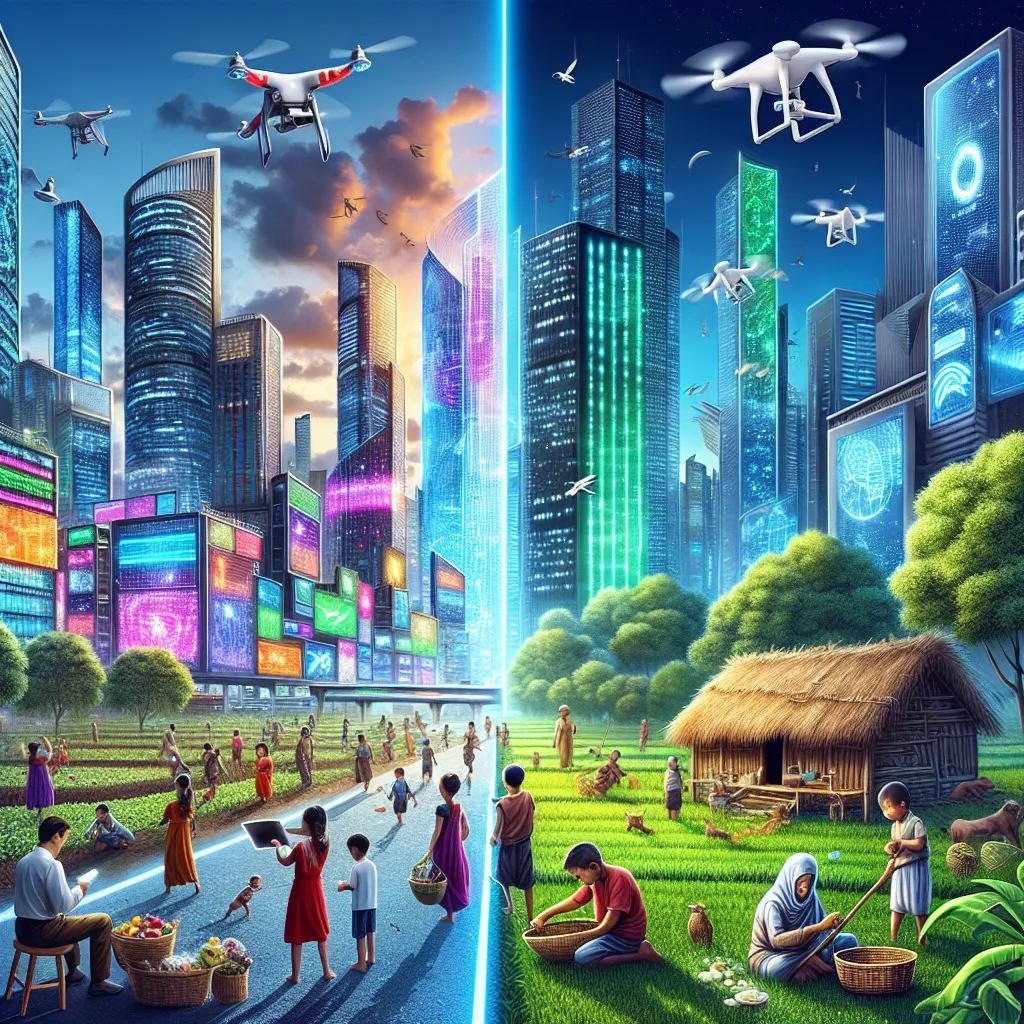The topic of addressing the digital divide in rural areas has been gaining prominence in IELTS Writing Task 2 essays. Based on recent trends and the increasing global focus on digital equality, it’s likely that this theme will continue to appear in future IELTS exams. Let’s explore this topic through a carefully selected question and provide sample essays for different band scores.
Nội dung bài viết
 Digital divide in rural areas
Digital divide in rural areas
Analyzing the Question
Let’s examine a typical IELTS Writing Task 2 question on this topic:
The digital divide between urban and rural areas is widening. What are the causes of this problem, and what measures can be taken to address it?
This question is a classic example of a problem-solution essay. It requires candidates to:
- Identify the causes of the widening digital divide between urban and rural areas
- Propose solutions to address this issue
The question touches on a relevant global issue, making it an excellent topic for IELTS candidates to showcase their analytical and language skills.
Sample Essay 1: Band 8-9 Level
Here’s a high-scoring sample essay that addresses the question comprehensively:
The disparity in digital access between urban and rural regions has become increasingly pronounced in recent years. This essay will explore the root causes of this growing divide and suggest potential remedies to bridge the gap.
The primary factors contributing to the digital divide are infrastructural and economic in nature. Firstly, the geographical remoteness of many rural areas makes it financially challenging for telecommunications companies to invest in high-speed internet infrastructure. The cost-benefit ratio often discourages these firms from extending their networks to sparsely populated regions. Secondly, rural communities typically have lower average incomes compared to their urban counterparts, making it difficult for residents to afford digital devices and internet subscriptions. This economic barrier further exacerbates the digital gap.
To address this issue, a multi-faceted approach involving both government intervention and private sector participation is necessary. One crucial measure is for governments to implement policies that incentivize telecommunications companies to expand their services to rural areas. This could include tax breaks, subsidies, or public-private partnerships that make rural expansion financially viable for these companies. Additionally, governments should invest in digital literacy programs tailored for rural populations, ensuring that once access is provided, residents can effectively utilize digital technologies.
Another effective strategy would be to leverage emerging technologies such as satellite internet or mobile broadband to overcome geographical barriers. These solutions can provide high-speed internet access without the need for extensive physical infrastructure. Furthermore, initiatives to provide affordable devices and internet plans specifically for low-income rural households could help overcome the economic hurdles.
In conclusion, while the digital divide between urban and rural areas is a complex issue, it is not insurmountable. Through a combination of targeted government policies, innovative technological solutions, and collaborative efforts between the public and private sectors, significant progress can be made in bridging this gap. Ultimately, reducing the digital divide is crucial for ensuring equal opportunities and inclusive growth in an increasingly digitalized world.
(Word count: 309)
Analysis of Band 8-9 Essay
This essay demonstrates several qualities that contribute to its high band score:
- Task Response: The essay fully addresses all parts of the task, discussing both causes and solutions comprehensively.
- Coherence and Cohesion: The ideas are logically organized with clear progression throughout the essay. Paragraphs are well-linked, and cohesive devices are used effectively.
- Lexical Resource: The essay uses a wide range of vocabulary with very natural and sophisticated control of lexical features. Examples include “disparity,” “pronounced,” “exacerbates,” and “multi-faceted approach.”
- Grammatical Range and Accuracy: The essay displays a wide range of structures with full flexibility and accuracy. Complex sentences are used effectively without errors.
Sample Essay 2: Band 6-7 Level
Here’s a sample essay that would typically score in the Band 6-7 range:
In today’s world, there is a growing gap in digital access between cities and rural areas. This essay will discuss why this problem is happening and suggest some ways to fix it.
One main reason for the digital divide is that rural areas often lack good internet infrastructure. Companies don’t want to spend money on building networks in places with few people because it’s not profitable. Also, people in rural areas usually earn less money than those in cities, so they might not be able to afford computers or internet plans.
To solve this problem, the government should take action. They could give money or tax benefits to companies to encourage them to build internet networks in rural areas. This would make it more attractive for businesses to invest in these places. The government could also start programs to teach people in rural areas how to use computers and the internet.
Another solution could be to use new technology like satellite internet. This doesn’t need as much physical infrastructure and could reach remote areas more easily. The government could also help rural people buy computers and internet plans at lower prices.
In conclusion, the digital divide between urban and rural areas is a big problem, but it can be solved. If the government and companies work together and use new technologies, they can help bring internet access to rural areas. This is important because in today’s world, everyone needs to have access to digital technology to have equal opportunities.
(Word count: 253)
Analysis of Band 6-7 Essay
This essay demonstrates characteristics typical of a Band 6-7 score:
- Task Response: The essay addresses the task, covering both causes and solutions, but with less depth and development compared to the Band 8-9 essay.
- Coherence and Cohesion: The essay is generally well-organized, but the linking between ideas is less sophisticated.
- Lexical Resource: The vocabulary used is adequate for the task, but lacks the range and sophistication of higher band scores. There’s some attempt at using less common vocabulary (e.g., “infrastructure,” “profitable”).
- Grammatical Range and Accuracy: The essay uses a mix of simple and complex sentence structures with generally good control, though lacking the full flexibility of higher bands.
Key Vocabulary to Remember
Here are some important vocabulary items related to this topic:
-
Digital divide (noun) – /ˌdɪdʒɪtl dɪˈvaɪd/ – The gap between those who have access to modern information and communication technology and those who don’t.
-
Infrastructure (noun) – /ˈɪnfrəstrʌktʃər/ – The basic physical and organizational structures needed for the operation of a society or enterprise.
-
Incentivize (verb) – /ɪnˈsentɪvaɪz/ – To motivate or encourage someone to do something by offering them a reward.
-
Exacerbate (verb) – /ɪɡˈzæsəbeɪt/ – To make a problem or bad situation worse.
-
Multi-faceted (adjective) – /ˌmʌltiˈfæsɪtɪd/ – Having many different aspects or features.
-
Leverage (verb) – /ˈliːvərɪdʒ/ – To use something to maximum advantage.
-
Viable (adjective) – /ˈvaɪəbl/ – Capable of working successfully; feasible.
-
Disparity (noun) – /dɪˈspærəti/ – A great difference or inequality.
-
Inclusive (adjective) – /ɪnˈkluːsɪv/ – Not excluding any section of society or any party involved in something.
-
Tailored (adjective) – /ˈteɪləd/ – Made or adapted for a particular purpose or person.
Conclusion
Tackling the digital divide in rural areas is a complex but crucial topic in today’s interconnected world. As we’ve seen from the sample essays, this theme allows IELTS candidates to demonstrate their analytical skills and language proficiency across various band scores.
For future practice, consider exploring related topics such as:
- The impact of the digital divide on education in rural areas
- The role of renewable energy in rural electrification and its effect on digital access
- Strategies for promoting digital literacy in underserved communities
Remember, the key to success in IELTS Writing Task 2 is practice. Try writing your own essay on this topic and share it in the comments section below. This active practice will help you improve your writing skills and prepare you for success in your IELTS exam.
For more information on related topics, you might find these articles helpful:


